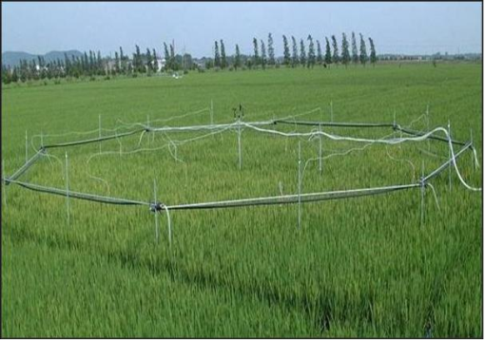Tropospheric ozone (O3) is regarded as the atmospheric pollutant that is most likely to threaten crop production globaly. To investigate the negative effects of O3 on Asian crops under open-air field condition, the research group lead by Prof. Zhu Jianguo at Institute of Soil Science, Chinese Academy of Sciences has developed an Free-Air Concentration System with ozone (FACE-O3) in Jiangsu Province, China since 2007 (Tang et al., Atomspheric Environment, 2011, 45, 6276–6282).
With the findings of the FACE-O3 experiments, the O3 flux dose–response relationships for wheat were established to predict the yield loss. This relationship as well as other flux-based and exposure-based relationships derived from European OTC experiments were combined with a high resolution chemical transport model (CTM) to give a regional evaluation of O3-induced wheat production loss in China and India at present and in the future. Relative yield loss (RYL) of wheat in 2000 was estimated to be 6.4–14.9% for China, and 8.2–22.3% for India. For the future projection, all the O3 dose metrics gave comparable estimates of an increase in RYL from 2000 to 2020 in the range of 8.1–9.4% and 5.4–7.7%for China and India, respectively (Tang et al., Global Change Biology, 2013, 19, 2739–2752).
As China and India are the largest and second largest wheat producers in the world, the substantialwheat production loss projected for these two countries in the near future indicates an urgent need forcurbing the rapid increase of surface O3 in these regions.

Fig. 1 FACE-O3 experiment

Fig. 2 The distribution of wheat production losses in China and India in year 2020 relative to year 2000
(Information Source: Institute of Soil Science, CAS)

